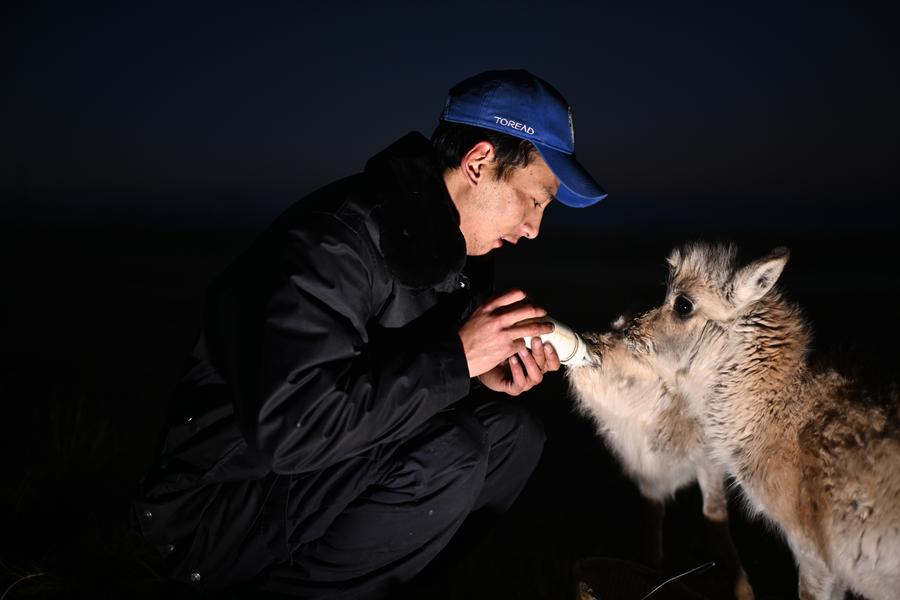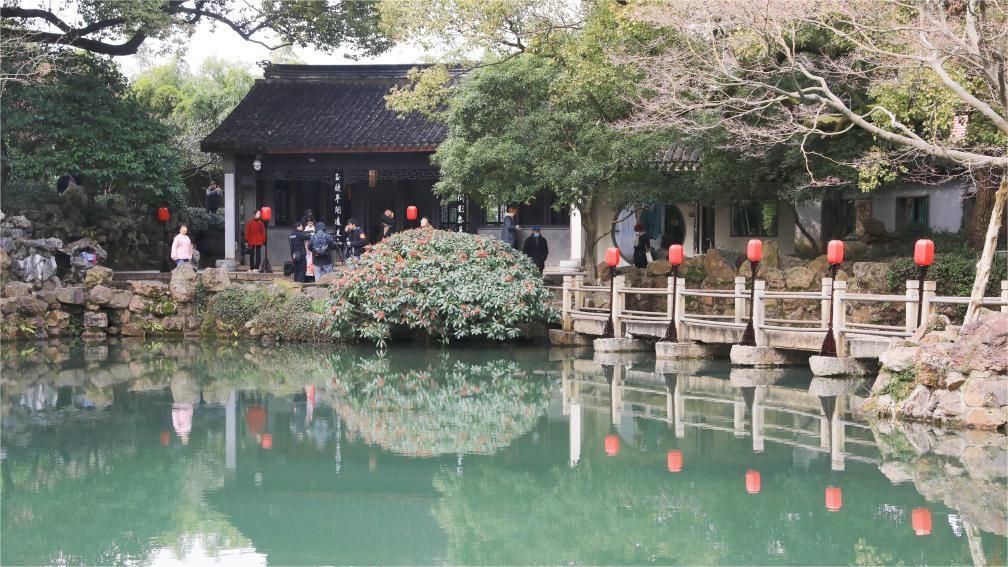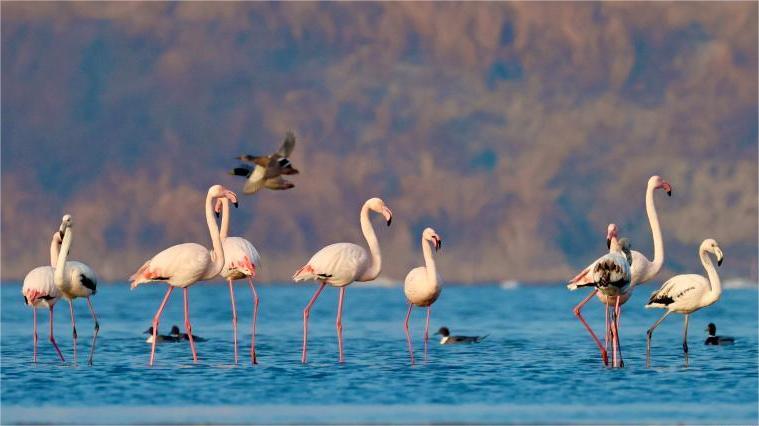Tech innovations enhance wildlife conservation on "roof of the world"
XINING, March 3 (Xinhua) -- On the eastern edge of northwest China's Hoh Xil, a nature reserve encompassing the country's largest area of uninhabited land within the Sanjiangyuan National Park, stands a striking statue of a Tibetan antelope against the backdrop of the azure sky.
This symbolic figure marks the first protection station in the region. Established in 1997, the Sonam Dargye Protection Station pays homage to a renowned guardian of Hoh Xil and now spearheads wildlife conservation efforts in the area. Sonam Dargye, a government official and advocate for wildlife preservation, tragically lost his life in 1994 at the hands of antelope poachers who turned their weapons against him.
Though Sonam Dargye has passed, his spirit endures. Thirty years on, his extraordinary commitment has inspired more people in Hoh Xil to guard this land with passion and dedication. "I heard about his deeds at a very young age, and I was deeply moved. I was determined to follow in his footsteps and become a guardian of this land," said Tsering Lozang, 24, the youngest ranger at the Sonam Dargye Protection Station. Last June, after graduating from university, he arrived at Hoh Xil to take on this job.
For the new generation of rangers like Tsering Lozang who patrol the expansive plateau landscape, beyond the spiritual inspiration, a string of new technologies deployed in biodiversity conservation in Hoh Xil also play a crucial role in their routine work on the "roof of the world."
On this year's World Wildlife Day, observed on Sunday, attention has turned to the remarkable progress achieved in these nearly uninhabited areas, with an average altitude of over 4,600 meters, as well as the pivotal role played by advanced technology in safeguarding wildlife.

Pregnant Tibetan antelopes move across the Qinghai-Tibet highway in Hoh Xil, northwest China's Qinghai Province, May 29, 2023. (Xinhua/Zhang Hongxiang)
Nestled deep in the Qinghai-Xizang Plateau, the Hoh Xil nature reserve had long grappled with a dearth of communication signals, save for the route along the Qinghai-Xizang Highway.
The convenience of sending frequent updates to colleagues and sharing photos of Tibetan antelopes roaming in the wilderness was once unimaginable for many rangers in the nature reserve. "Entering the nature reserve meant being isolated from the outside world, especially in the Zonag Lake area. We could only contact families through expensive satellite phones," recalled Tsesogyal, a 28-year-old ranger in Hoh Xil.
During the last Tibetan antelope breeding season, a 5G base station began operations at the protection station near Zonag Lake, known as the "delivery room" for Tibetan antelopes, a species under first-class state protection in China.
This marked the expansion of the 5G network throughout the core territory of this UNESCO natural heritage site. Now it is possible to livestream one of the world's most breathtaking scenes, migrations of hoofed animals, to the global audience.
According to Zhan Jianglong, a local forest police official, the change still feels "like a dream." "Having cellphone signals in the wilderness used to be unbelievable," he said. Nowadays, there is uninterrupted 5G signal, with the peak internet speed reaching 860 Mbps.
"In the past, communication with the outside world was difficult during the journey. Now, when we reach the area near Zonag Lake, everyone can easily call their families and colleagues via phone or WeChat," Zhan said.
As early as 2016, Qinghai Province began to build a networked, remote real-time observation system to strengthen the monitoring and protection of key ecological areas.
Known as the "window of ecology," the remote monitoring system has 76 observation points across the area. It can not only closely observe and study the migration process of Tibetan antelopes but also facilitate data collection and observation of rare wildlife species, providing detailed data support for biodiversity conservation in the Sanjiangyuan National Park.

A ranger feeds a rescued Tibetan antelope cub at the Sonam Dargye Protection Station in Hoh Xil, northwest China's Qinghai Province, Jan. 18, 2024. (Xinhua/Zhang Hongxiang)
"It is a significant step in Sanjiangyuan National Park's pursuit of intelligent ecological protection," said Sun Lijun, deputy director of the Sanjiangyuan National Park administration.
Sun noted that based on the geographical factors and ecological monitoring requirements, the park chose to set up the 5G base station in the Zonag Lake area, which can better monitor the migration and delivery of Tibetan antelopes.
According to deputy station chief Guo Xuehu, staffers of the nature reserve rescue many Tibetan antelope calves separated from their herds at the Zonag Lake Protection Station every year. "Now, when a calf falls ill, we can also use video calls to connect with veterinarians, who can guide the treatment remotely."
"Livestreaming Tibetan antelope migration and birth also helps foster public awareness for biodiversity conservation," Sun added.
According to local authorities, more 5G base stations are expected to be built in the nature reserve, while the combination of 5G remote inspection, on-site patrol and helicopter patrol will be introduced to bolster the anti-poaching and monitoring capabilities of the reserve.

An aerial drone photo taken on June 17, 2023 shows the 5G base station at the Zonag Lake Protection Station in Hoh Xil, northwest China's Qinghai Province. (Xinhua/Zhang Hongxiang)
Research on Tibetan antelopes, one of the flagship species on the Qinghai-Xizang Plateau, has always been important for protecting the plateau's biodiversity, according to Lian Xinming, a researcher at the Northwest Institute of Plateau Biology, Chinese Academy of Sciences.
Hailing the technological advancements in wildlife conservation atop the "roof of the world," Lian noted that in the future, AI technology can be used to monitor the reproductive status of Tibetan antelopes. This approach would reduce human resource input and statistical errors, thus enhancing the efficiency of ecological protection and scientific research in Hoh Xil.
Photos
Related Stories
- Wuhu City in E China makes efforts to restore ecological environment of Yangtze River
- Snow leopard conservation alliance established in China's Qinghai
- Ecological guardianship helps increase population of world's rarest primate
- Chinese experience helps ecological restoration efforts in Mongolia
- Pic story: research team on protecting ecological environment in Inner Mongolia
Copyright © 2024 People's Daily Online. All Rights Reserved.









